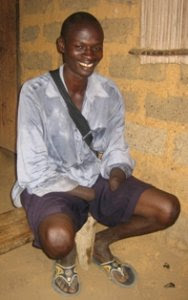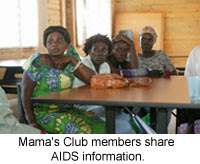The Long Tail - by Bill Brick in Uganda
“I plan to end our relationship with Kiva next week, unless … (rattles off a laundry list of consequential things for Kiva to change immediately). I like Kiva very much - nice people, very smart, hard-working, doing fine things. Kiva has served our needs well. But I’m afraid we’ve graduated beyond Kiva. I’m not sure how you can help me, or even why you are here.”
Sometimes the most auspicious beginning is the best ending in disguise. And so my Fellowship with BRAC Uganda began. And ended. No Brick at BRAC.
My road to Kampala began nearly 7 months ago. In actuality, it probably began several years earlier when I was discovering myself among peasants in the slums of South America and Asia. Since submitting my application in March, volunteering with Kiva has dominated my conscious and much of my activity. I’ve shuffled my career, learned how to blog, let my pilot’s license lapse, undergone exhaustive Kiva training and now, I’m allowing the fall surfing season in Northern California to slip past and, mainly, I’ve left behind my life’s love (and her sweet but unusual dog). To be a Fellow is to sacrifice and adapt, fluidly. We have trained and prepared for the unexpected; make no mistake, this is the third world.
A poignant question indeed: why am I here, and how can I help? Standing at the precipice of the unknown is, I suppose, as addicting as it is unsettling - self doubt chases excitement; anticipation wrestles with fear. What drives us to explore? We come for cause, yes, but what is it really we hope to gain? What drives these ambitions? But I realize such abstractions are only distractions. Answers will reveal themselves in time, but only once in Uganda, boots on dirt, working hand-in-glove with BRAC…reducing poverty…learning a new culture…leaving Uganda in better shape than I found it. I feel my youth reawakened! And so in the days leading up to my departure, my singular and most tangible goal was to engage deeply in this enterprise and immerse myself entirely in my occupation, with purpose and conviction.
As this unexpected, discouraging and indeed demoralizing dialog with Mr. Arif, BRAC’s Country Director, concluded, I wanted to know what “graduated beyond Kiva” meant. To learn this, I had to learn about BRAC (as best I could while cordially being shown the door).
BRAC is a pioneering international development organization that began operations in Bangladesh as a small-scale relief and rehabilitation project in 1972 (a few years before the inception of it’s more famous neighbor, Grameen Bank) to help the country overcome the devastation of the liberation war. Its primary focus was on the resettlement of refugees returning from India. Today, BRAC is an independent, self-financed standard in sustainable human development. It is one of the largest Southern development organizations employing over 100,000 people and working with the twin objectives of poverty alleviation and empowerment of the poor, especially women. Diagnosing poverty in human terms and recognizing its multifaceted nature, BRAC approaches poverty alleviation with a holistic approach, providing a comprehensive, integrated suite of programs for income and wealth creation, education, health care and business training. BRAC does much more than make loans. The idea is to employ tools like microfinance to reduce poverty today, and programs like primary education for girls to halt poverty’s perpetuance in the future.
BRAC’s successful story over the years has been guided by its vision of “a just, enlightened, healthy and democratic society free from hunger, poverty, environmental degradation and all forms of exploitation based on age, sex, religion and ethnicity.” Most recently, BRAC expanded its development interventions beyond its borders into Central Asia and Africa. Uganda is the first country BRAC expanded into outside of Asia, and has serves as its flagship branch in Africa. BRAC began working with Kiva shortly after it established its initial footprint in Africa. Sometime within the next year, BRAC in Uganda will grow to nearly 100 branches, with over 800 employees and a gross loan portfolio of $28 million, and will serve over 100,000 clients. Wall Street, take notice: BRAC Uganda’s loan portfolio is performing with 0% defaults!
BRAC’s “target market” is the lower 50% of the impoverished; the poorest of the poor, many rejected or ignored by competing MFI’s. While global in scale, it operates in the grassroots and very much on a personal level. BRAC is exceptionally well-managed, keenly focused on process, efficiency, cost control, productivity, sound business practices and, of course, results. Its discipline to these principles explains BRAC’s impressive track record in Uganda, which in turn demonstrates that BRAC can successfully and swiftly emerge into new regions beyond Asia. Success begets success; recently, the Clinton Global Initiative made a multi-hundred million dollar investment in BRAC, and many other institutions have taken notice and are following suite (both not- and for-profit organizations). Kudos to Kiva for recognizing a diamond in the rough and making an early investment in its potential.
Membership in BRAC is a badge of honor. To its group members, it represents a chance to strive towards positive change in their quality of life, knowing that something big has their back, and understands their plight and is putting its core resources in support of them, their businesses and their vision for the future.
In short, BRAC Uganda probably has outgrown Kiva, and that’s good news.
“You see, Bill, Kiva may not charge me interest, but its money is not without cost.” Mr. Arif continues, “My business has scaled dramatically in the past year and I can no longer absorb the operational costs of funding individual loans with Kiva. I’m now able to borrow in very large sums, and very efficiently.”
I then recall The Long Tail discussion from our training in San Francisco a few weeks ago; it’s then I see that this is not a loss for the Kiva ecosystem, but an intended right of passage, much like college matriculation. Bittersweet perhaps, but triumphant. Huh? Let me explain.
Kiva recognizes that the internet is a promising vehicle to reduce costs, build capacity and distribute risk in Tier 2 - Tier 4 MFIs, broadly defined as young and/or local MFI’s with strong management practices and social values, but which are constrained by capital and resources, certainly on a large scale. By providing risk-tolerant funding for individual loans, (Kiva lenders are social investors, not financial investors), Kiva serves an incubator of sorts, fulfilling a dual role of (a) accelerating MFI’s, like BRAC, progress up-Tier and, (b) helping others achieve self-sufficiency. In the graphic below, Kiva fostered BRAC Uganda’s move into an exclusive category of global MFIs which can attract vast appropriations from large institutions. With Kiva, BRAC Uganda is now reaching many tens of thousands of clients throughout Uganda and is delivering more services to the people who need them most. Kiva has done its job with BRAC Uganda! We should all be proud of that success. As of this writing, Kiva lenders have reached 1,078 borrowers in less than a year, with an aggregate funding amount of over $1.6 million. That’s an amazing impact!
So exactly what is Kiva’s value to lower-Tier MFI’s? In fact, it’s profound. The capital structure of lower-Tier MFI’s consists of a significant percentage of donor capital and high-cost commercial debt from lending or alternative investment firms. Donor capital is not sustainable and commercial structures are restrictive and their high costs are pushed onto the borrowers who can afford them the least. Further, resource limitations constrain their capacity to build infrastructure that’s needed to scale and sustain competitive position. Kiva solves many problems central to these organizations, strategically and operationally; notably:
1. Reduces overall cost of capital
2. Increases profitability and accelerates sustainability
3. Helps MFI’s build capacity (related services like insurance, savings programs, health care, education and business training)
4. Helps build social performance tracking metrics
5. Provides a funding vehicle for riskier projects and innovation
6. Frees up capital to invest in infrastructure
7. Builds global awareness and brand, connecting local MFI’s with lenders and investors globally
In the end, scale matters and the ultimate goals of microfinance, as a global industry, are to (a) reach as much of the world’s poor as possible, sustainably and, (b) deeply integrate into the mainstream financial sector, one day eliminating its dependence on donor capital and government support. With scale and inclusion, featuring BRAC Uganda as a case study, comes:
1. Lower transactions costs
2. Greater capacity
3. Broader reach
4. Lower cost to members
5. Highest levels of transparency
6. Unlimited (essentially) access to market-based capital
7. For better or worse, Kiva can (but not de facto) become an impediment beyond some inflection point on the Long Tail curve.
So what’s next for me in East Africa? I haven’t the first clue! But I do know that there’s plenty of poverty in Uganda; no shortage of good work to do. That is Kiva’s purpose and commitment (thank you Ben and JD!), and it is mine until January 2. Kiva has several MFI partners in Uganda and many more that want to be. All have real business problems, each needs real solutions. And I’m an entrepreneur; which is to say, a problem solver. A true adventure, afterall, yields only an unforeseen and complex outcome. Uncertainty is the only certainty. Stay tuned.
later man, jan









_mamas_club_meetin.jpg)

















